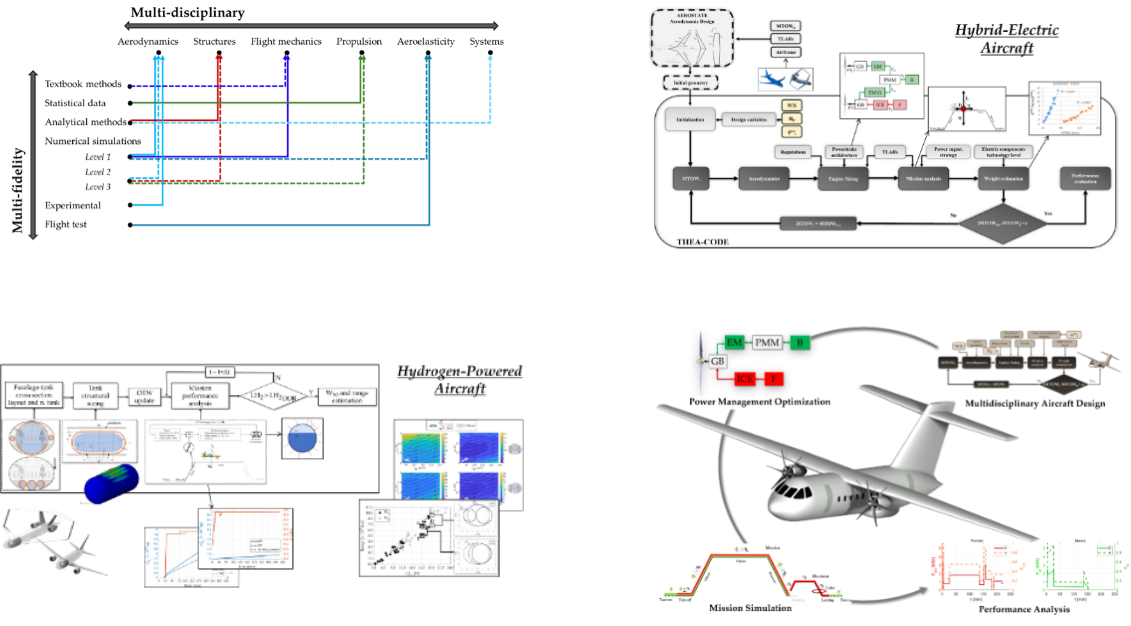Multidisciplinary design optimization of innovative aircraft
Air transportation is experiencing a significant transformation phase driven by the urgent need to address its environmental impact, which is expected to escalate in the near future. The research group focuses on the development and integration of innovative technological solutions designed to enhance the performance and efficiency with respect to the traditional thermal-powered tube-and-wing aircraft.
The core of the investigation is the study of the integration of breakthrough technologies starting from the very early stages of the aircraft design process. Main research topics include the electric and hybrid-electric propulsion, hydrogen propulsion, and advanced airframe architectural solutions. Specifically, new airframes such as box-wing are currently investigated to increase aircraft lift-to-drag ratio and improve aircraft performance.
The research activity is grounded on a comprehensive and multidisciplinary approach to develop models and methods to properly address design, integration, simulation, and impact analysis of the novel techno-bricks in the overall aircraft design workflow. Our strategy is based on multidisciplinary integrations, effectively linking aerodynamics, structures, propulsion, and flight mechanics, together with a multi-fidelity approach, to set-up customized tools, with the proper level of detail for each stage of the design. These tools are to be properly integrated in the conceptual design framework which ensures thorough and coordinated links across all disciplines, enabling the so-called multidisciplinary design optimization, i.e. the optimization of the overall design and performance of novel aviation configurations.

MUL2 Investigators
Karim Abu Salem, Giuseppe Palaia, Enrico Zappino, Erasmo Carrera
Reference papers
- Abu Salem K., Palaia G., Quarta A.A., “Review of hybrid-electric aircraft technologies and designs: Critical analysis and novel solutions,” Progress in Aerospace Science, 2023, vol. 141. https://doi.org/10.1016/j.paerosci.2023.100924
- Palaia G., Abu Salem K., Carrea E., “Preliminary Performance Analysis of Medium-Range Liquid Hydrogen-Powered Box-Wing Aircraft,” Aerospace, 2024, vol. 11. https://doi.org/10.3390/aerospace11050379
- Abu Salem K., Palaia G., Cipolla V., Binante V., Zanetti D., Chiarelli M., “Tools and methodologies for box-wing aircraft conceptual aerodynamic design and aeromechanic analysis”, Mechanics & Industry, 2021, vol. 22. https://doi.org/10.1051/meca/2021037
- Palaia G., Abu Salem K, “Mission Performance Analysis of Hybrid-Electric Regional Aircraft,” Aerospace, 2023, vol. 10. https://doi.org/10.3390/aerospace10030246
- Abu Salem K., Cipolla V., Palaia G., Binante V., Zanetti D., “A Physics-Based Multidisciplinary Approach for the Preliminary Design and Performance Analysis of a Medium Range Aircraft with Box-Wing Architecture,” Aerospace, 2021, vol. 8. https://doi.org/10.3390/aerospace8100292
- Palaia G., Abu Salem K., Quarta A.A., “Comparative Analysis of Hybrid-Electric Regional Aircraft with Tube-and-Wing and Box-Wing Airframes: A Performance Study,” Applied Science, 2023, vol. 13. https://doi.org/10.3390/app13137894
- Abu Salem K., Palaia G., Chiarelli M.R., Bianchi M., “A simulation framework for aircraft take-off considering ground effect aerodynamics in conceptual design,” Aerospace, 2023, vol. 10. https://doi.org/10.3390/aerospace10050459